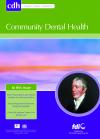Community Dental Health

- Cover Date:
- March 2007
- Print ISSN:
- 0265 539X
- Vol:
- 24
- Issue:
- 1
Editorial - Expanding dental undergraduate clinical outreach programmes into general dental practice.
Placing dental students for part of their clinical programme in NHS primary care settings, so called outreach programmes, is now well established in many UK dental schools. The General Dental Council (2002) in its guidance to Dental Schools noted that “an extended clinical environment and outreach teaching can potentially broaden the base of available clinical material and enhance the educational experience†and that “in pursuit of this students may, under supervision by University recognised teachers, operate in the following situations (among others) • all systems for the delivery of primary dental care approved by the schools for these purposes • approved community dental service clinics • and personal dental services†Outreach programmes have long been established and evaluated in the USA (Baillit, 1999) and also in Scandinavia. In the UK some of the earliest initiatives involved community dental service (CDS) settings (Holloway and Dixon, 1977) and more recently dental access centres (DACs) (Smith et al 2006a). However general dental practice was always seen, until very recently, as a step-too-far. The predominant fee-per-item payment system, the rather complex semi-detached relationship with the NHS under which these practices operated, and medico-legal issues around indemnity were all perceived as obstacles. However new legislation has opened up new opportunities. The Health Authorities Act (1995) abolished family health service authorities and integrated primary and secondary care within the health authority structures, while the National Health Services (Primary Care) Act (1997) introduced the personal dental service (PDS). The PDS provides for much greater local autonomy for both the health authority and practitioners to agree objectives and terms and conditions of service, and usually replaces the traditional fee-for-item of service with variations on a capitation payment system (NHS (Personal Dental Services Agreements) Regulations 2005). Lennon et al (2004) described a pilot study in Liverpool in which six students were located in two PDS practices for 11 days. The students gained a wide clinical experience including adult restorative dentistry, working with a dental team including dental nurses and dental therapists, developing their communication skills and beginning to appreciate the importance of a social history in planning an appropriate treatment plan. Patient evaluation was very positive and none raised any objections to paying customary NHS charges. The study concluded that “it is both feasible (in terms of preparation, support and monitoring of student learning) and educationally beneï¬cial to provide an undergraduate programme in a PDS setting†but the study recognised that further research was required into the cost of such programmes and into the availability of suitable general dental practices that would be willing to host dental students. At the University of Shefï¬eld a three year pilot programme conï¬rmed the beneï¬ts of outreach for students. An evaluation based on a randomised controlled trial demonstrated that outreach experience increased students’ conï¬dence (Smith et al, 2006b) and developed treatment planning abilities that took account of patients’ social circumstances (Smith et al 2006c). A parallel pilot study in four PDS practices conï¬rmed the results of the earlier Liverpool evaluation. As a result of these positive ï¬ndings, and as part of its response to the recent increase in student numbers, the Shefï¬eld Dental School has established outreach as a permanent feature of its curriculum and extended the programme from six weeks to six months. In order to provide sufï¬cient placements it was decided to expand provision in all settings, including CDS and DACs, but particularly to expand provision within PDS. To determine the availability of willing and suitable general dental practices the local consultants in dental public health, John Green and Nigel Thomas, wrote to all practices in South Yorkshire, a total of 208 practices, of whom 20 expressed a strong interest and 12 subsequently submitted formal bids. In making a selection, local consultants in dental public health, the dental practice advisors, the postgraduate deanery, the health authority and university colleagues were involved; a ï¬nal list of ï¬ve PDS practices providing an additional 18 dental chairs were selected. Capital funding of £1.5 million to support this expansion into PDS was provided by the (former) South Yorkshire Strategic Health Authority and recurrent funding of around £23,000 per annum per chair will be allocated through Dental SIFT (an NHS funding stream designed to cover the additional costs of hosting medical/dental students within NHS hospitals/clinics). Of course these are early days not only for outreach in general dental practice but also for the new NHS general dental practice contract, and continued evaluation and sharing of experience will be crucial. Nevertheless the enthusiastic response of the students and staff involved so far, careful attention to clinical and academic governance, combined with the strong support of our local PCT (health authority) allows us to be optimistic that outreach in general dental practice will make a substantial and increasing contribution to dental education. M A Lennon OBE Clinical Professor, University of Shefï¬eld Emeritus Professor, University of Liverpool
- Article Price
- £15.00
- Institution Article Price
- £
- Page Start
- 2
- Page End
- 3
- Authors
Articles from this issue
- Title
- Pg. Start
- Pg. End
- Editorial - Expanding dental undergraduate clinical outreach programmes into general dental practice.
- 2
- 3
- Agreement amongst examiners assessing dental fluorosis from digital photographs using the TF index.
- 21
- 25
- Enamel defects and its relation to life course events in primary dentition of Brazilian children: A longitudinal study
- 31
- 36
- Knowledge of and attitudes toward severe acute respiratory syndrome among a cohort of dental patients in Hong Kong following a major local outbreak
- 43
- 48
- An audit of paediatric dental treatments carried out under general anaesthesia in a sample of Spanish patients
- 55
- 58
